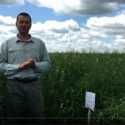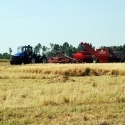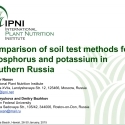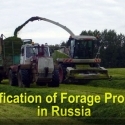08 Dec 2011
Russian Agriculture Performance
 Rye field
Rye field
Agricultural production in Russia is particularly subject to frost and drought. Fertilization accounts for about 10% of crop yields in the south to more than 30% in north Russia. According to the last soil survey (2005), 42% of Russia’s arable soils are low in humus, 44% have unfavorable acidity level and need lime, 21% are low and very low in P, and 10% low and very low in K. Fertilizer efficiency is low because of the problems with soil acidity.
Russian farms can be classified as agricultural enterprises, private farms, and household plots. Household plots account for 52% of crop production, followed by agricultural enterprises (42%) and private farms (6%). About 72% of the land remains in large farm enterprises, the successor of the collective and state farms. Large farm enterprises produce 42% of agricultural output on 72% of the land, while the household plots and private farms produce 58% of the output on 13% of the land. During the last 7 years, private farms and household plots have increased output fourfold with negligible expansion of farm size. Agricultural enterprises dominate in cereals, sugar beet, sunflower, and egg production, hereas private farms and households dominate in potato and vegetable production. Agricultural enterprises vary greatly in efficiency. Profitability of the 300 best agricultural enterprises is estimated at 3 to 4 times above the average enterprise.
For most crops, the fall in agricultural production between 1992 and 1999/2001 was due largely to a reduction in the harvested areas, not yields … the poorer, marginal land with very low yields was taken out of production. Overall average yields have fallen substantially in only one or two crops, but the area of arable crops, excluding forage crops, fell by 30%. More than half of harvested area is traditionally occupied by cereals, followed by fodder crops (25%), oil and technical crops (10% each), whereas potatoes and vegetables occupy only 5%. Starting from 1992, the share of fodder crops was significantly reduced, while technical and oil crops almost tripled and doubled in area. Animal husbandry was the sector most affected during the restructuring of agriculture that has taken place since 1991.
With the collapse of the Soviet Union in 1990, fertilizer consumption decreased dramatically. And despite the slight increase during the last 5 years, it is now only 15% of the level in 1990. There are many reasons responsible for the decrease in fertilizer use. First, share of fertilized area shrunk in two ways. In 2006, only 34% of total sown area was fertilized, despite the positive trend during the last 5 years. Second, fertilizer application rates for almost all crops decreased substantially. The most significant fall was for sugar beet (186 kg/ha), flax (134 kg/ha), sunflower (69 kg/ha), and fodder crops (68 kg/ha). Because of the very large area involved (42 M ha), the reduction in fertilizer rates on fodder crops accounts for 38% of the total drop in fertilizer consumption. As a result, average application rate has been reduced from 88 to 27 kg of nutrients/ha. According to estimates of the All-Russian Research Institute for Agrochemistry, the balanced ratio in mineral fertilizer consumption should be 1:0.9:0.7, but the actual ratio is 1:0.44:0.28. Currently, the balance is negative for all nutrients, with a deficit of 22 kg N, 6.2 kg P, and 22.6 kg K per ha.
The main constraints to fertilizer use are summarized as follows: structure of agriculture and the lack of small and medium size enterprises, reduction of livestock numbers, low prices for commodity agricultural products, inadequate use of modern agricultural production, inadequate fertilizer distribution system, and collapse of the advisory and soil analysis system. Despite these constraints, there are emerging opportunities to increase consumption. The government initiated a national program on agriculture development in 2006 which is working to revive agricultural production in Russia. The program is focused on animal husbandry, stimulation of private farm production through subsidies for bank interest, establishment of cooperatives, land mortgages, and educating agricultural specialists. New legislation is opening the door for land turnover from the government, where profit potential will motivate production intensification. And like many other countries in the world, biofuels are driving the demand for greater production from sunflower and rapeseed for use in biodiesel.
The timing of the establishment of the IPNI program in Russia with these changes that are taking place makes us wellpositioned to impact the development of the fertilizer market as it moves forward. The opportunities and need for IPNI research and educational activities in this part of the world are great and we look forward to this challenge as we move IPNI programs forward in Russia and Central Asia.




